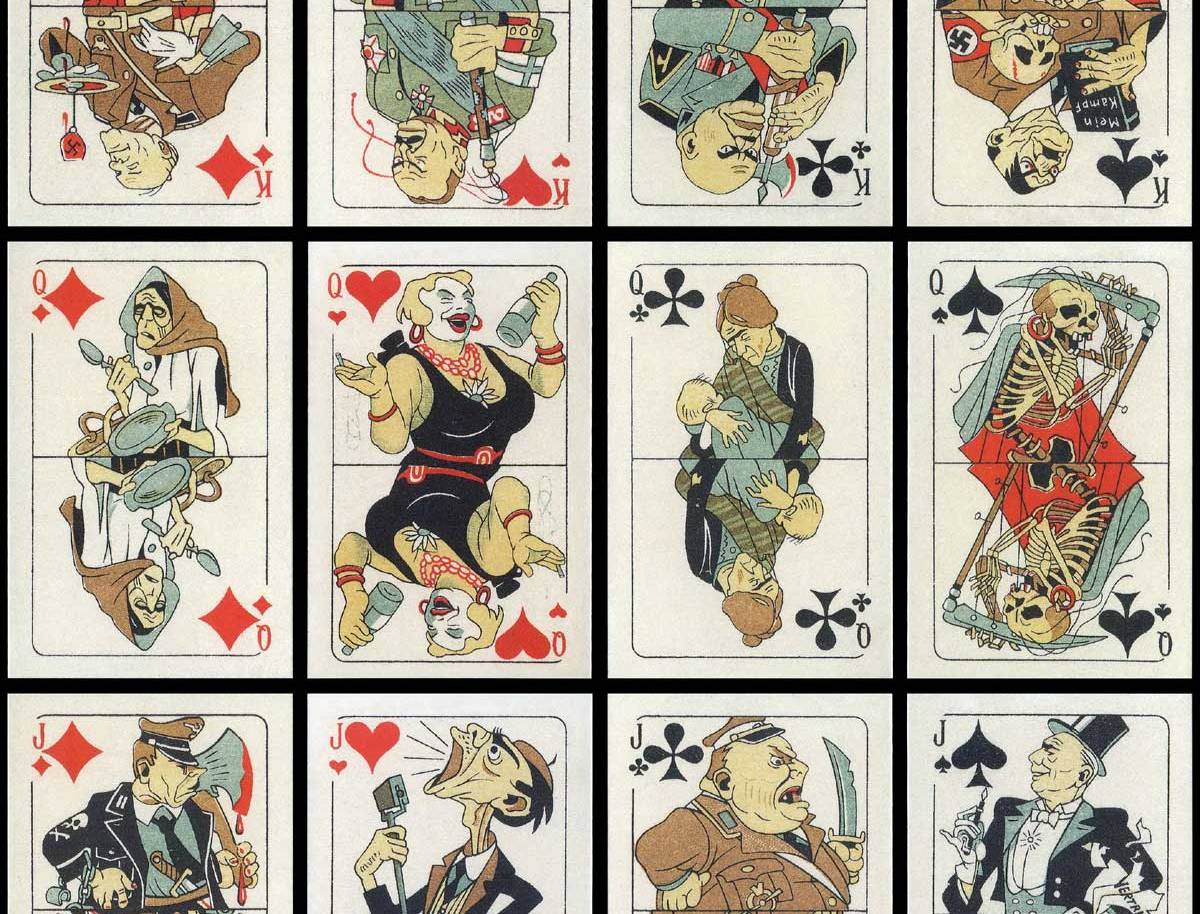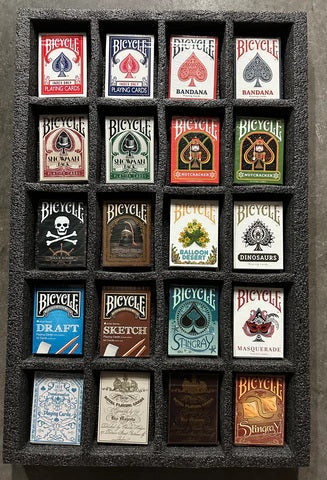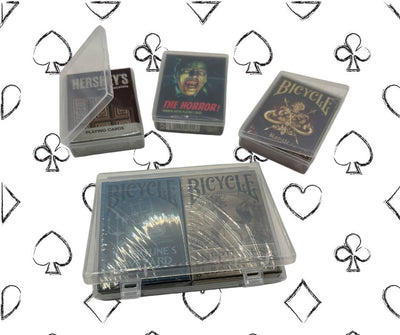Are customized playing cards a recent phenomenon? Given the massive boom in the playing card industry over the past decade, you might think so. The arrival of crowd-funding has certainly given the market a real shot in the arm, by opening up new opportunities for both creators and consumers, and it's arguably a golden era like never before. But people have always been producing and collecting custom playing cards right back to the 15th century, which is when the printing press helped playing cards spread rapidly through Europe. All along, besides their primary use for playing card games, playing cards have also been used to display things like art, history, geography, and other instructional materials. And in some instances these secondary purposes even superseded the original intention of the playing card, by becoming a purpose in itself.
That's especially the case in instances when decks of playing cards were produced specifically for the purpose of political propaganda. Commemorative decks have always been popular, and notable events such as royal wedding or the anniversary of an important battle were obvious candidates for playing cards themed around them. A case in point is a deck commissioned by Queen Elizabeth I in 1588, which apparently had the sole purpose of publicizing the defeat of the Spanish Armada, in a time when a regular mass media for disseminating global news didn't exist.
But playing cards haven't just been used to commemorate wars and victories, because they can also serve as tools to influence popular opinion in the middle of such conflicts. As an example of this during the First World War, Germany produced decks with court cards that featured Hitler and other German leaders. But two can play at that game, and the United States did something similar, with an American produced deck featuring military personnel on court cards, geared to bolster morale for their troops. This certainly wasn't the first time decks were used for propaganda purposes, and it wouldn't be the last.
Bill Schroeder's Seven Decks You'll Never Play Poker With
In his wonderful book Seven Decks You'll Never Play Poker With (Fedeli Publishing, 2014), Bill Schroeder details seven unusual decks that were produced specifically for propaganda. I'm indebted to his fascinating book for some of the information that follows.Schroeder offers pictures of playing cards from his own collection, and details the background behind seven unusual decks that he has first-hand knowledge of. I won't cover all of them in detail in this article, and in passing I'll just mention the 1934 National Recovery Administration deck which criticized President Roosevelt during the First New Deal. All copies of this deck were destroyed at the order of Roosevelt, except one lone copy which eventually found its way into Schroeder's hand, and which he appropriately describes as "The rarest deck of playing cards in America".
In his final chapter, Schroeder also details two educational decks known as the "Under Your Skin" decks. One was produced by a professor in Italy in 1978 as an educational aid for his students, and pictures different bones from the human skeleton; the other was produced by medical students in the Czech Republic in 1994, and pictures human anatomy. While unique, decks like these aren't entirely unusual in the modern market, which has witnessed some decks that commemorate the most unusual themes.
For the purpose of this article, of more interest than the above-mentioned decks are those that were created with political motives and intended as as political propaganda, such as the examples that follow.
In der Fuehrer's Face deck (1945, United States)
The first of these was authorized by President Roosevelt during World War II, and was an anti-Axis deck, designed to persuade Latin American countries to enter the global conflict against Hitler. With war against Germany imminent, Roosevelt wanted to curtail the influence and activity of the Axis forces in Central and South America, including in countries like Mexico. But with a largely illiterate population that couldn't read, combined with a demographic of poverty where the average person didn't own a radio, traditional methods of reaching the masses weren't really available. How could Roosevelt reach the people of these individual nations, and encourage the bond with the USA? With playing cards of course!At the time it was common practice to use posters featuring political cartoons, so the idea was floated to create a deck of playing cards with such political cartoons. The well-known Mexicon cartoonist Antonio Arias Bernal was the obvious candidate to accomplish this project, since his outspoken anti-Axis cartoons were already published worldwide. Over fifty cartoons were collated, including some new work by Bernal.
With the deck virtually ready to be published, the unexpected happened in April 1945: Roosevelt, Mussolini, and Hitler all died with 18 days of each other. There was no longer a need for the 250,000 planned decks of poker cards because the war was effectively over. Thus they were never published, and in lieu of them, a few hundred sets of poster-sized prints were instead printed in 1945 under the title "Album for World War II". The King of Spades (pictured below) was added after the war, and shows the Japanese emperor on his knees besides the smoking ruins of Hiroshima. Using photographs of the original prints, and under Schroeder's direction, 500 copies of a reproduction deck were finally printed in 2002.
The deck is now known as the "In der Fuehrer's Face" deck, and Schroeder has authored a separate book devoted to it (In der Fuerhrer's Face) , in which he covers the history of its origin, explains its content, and reprints images of all the cards.
Siege of Leningrad decks (1942 & 1943, Russia)
One of the ugliest parts of World World II is the lengthy Siege on Leningrad (1941-1944). Lasting for an incredible 872 days, and with both sides under instructions to fight to the death, there were an extraordinary number of casualties on both sides, as well as over a million civilians as a result of starvation. The offensive began in the middle of 1941, and the original plan was for the Germans to bring about victory before the harsh Russian winter. The extreme cold meant that hypothermia was the cause of death for many Nazi soldiers, who weren't properly equipped or clothed to deal with the extreme conditions of winter. On two occasions, the USSR sought to undermine the morale of the German soldiers on the front lines by dropping decks of propaganda playing cards from aircraft.When the efforts of the Russian military to break the siege weren't successful, the idea came about to attempt some psychological warfare. 700 decks of card were produced with political cartoons intended to show the Nazi leaders as incapable fools guiding their followers to certain ruin. Court cards featured Hitler as a war criminal, holding his beloved Mein Kampf and a skull (pictured below on the King of Spades). Other leading figures depicted on the court cards included individuals like Himmler, Goebels (famous for his propaganda, and pictured below on the Jack of Hearts), Goering, as well as conspirators from other nations like Mussolini.
Did the plan work? Not really. Many decks disappeared into the snow, and only showed up as soggy lumps of paper in the spring. While the decks promised German holders of the propaganda deck that these playing cards would function as a free pass to safety if they surrendered, the Germans offered a more harsh penalty for anyone possessing them: immediate court martial and execution. Becoming a Russian prisoner of war was likely not very appealing to German soldiers anyway.
But the Russians didn't give up yet, and the following year another propaganda deck was planned, with a similar aim. The concept was similar, but this deck was even more impressive from an artistic perspective. The leaders of the Nazis and the Axis countries were the obvious targets of the political satire, and these were depicted on the court cards in a very clever way. One side of the court card showed the individual at the height of triumph in 1941, while the other side of the court card cleverly gave a contrasting image that showed their poor state of affairs in 1943. For example, Mussolini is pictured on the Queen of Spades as a Grande Dame in 1941 but a poor war widow in 1943, while Hitler's 1943 profile on the King of Spades shows him being saluted with a broken sword. The idea was to make the German military lose hope and confidence in their own leaders. The decks weren't printed on time, and only became a reality in the early 2000s when a small number of copies were printed for collectors.
Anti-Religions deck (1931, Russia)
The Siege of Leningrad decks weren't the Russian's first shot at using playing cards for propaganda purposes. Under the influence of Marxisim, and the oft-quoted maxim "religion is the opium of the people", the USSR authorities took a very hard line towards all modern religions and churches, and in fact every religious organization. Religions were seen as means that would protect the working class, and thereby enemies of the Russian state.In view of the above, it won't come as a surprise that in 1925, with the encouragement of the Soviet government, a volunteer anti-religious organization was formed, under the name "Society of the Godless". They managed to persuade the powers that be to bankroll the printing of an Anti-Religion deck in 1930. This had an initial printing of only 500, and original copies of these decks are extremely hard to come by. A second print run followed the next year, with different card backs.
The deck assigned each of the suits to a different major religion: Clubs = Eastern Orthodox, Hearts = Roman Catholicism, Diamonds = Judaism, Spades = Buddhism. Oddly enough the images on the Spades appear to have more in common with Hinduism, but either a lack of scholarship on the part of the Russian artists can be blamed for this, or else it was intended as a deliberate smear against India.
The court cards focus on depicting prominent figures within each religion as hypocrites. For example, the rabbi on the King of Diamonds (pictured below) is reading the Torah while simultaneously catching money with his other hand. Meanwhile an Eastern Orthodox nun on the Queen of Clubs is dreaming of romance despite her outward actions of religious piety, while a praying Roman Catholic priest on the Jack of Hearts is occupied with similar lustful thoughts.
Oddly enough, the USSR tried to distribute the deck at the 1933 "Century of Progress" World's Fair in Chicago. This would naturally have sparked a religious controversy, and the end result was that the USSR didn't participate in the Fair. Given the extreme rarity of the original deck, a printing of a reproduction version in 2002 was welcomed by collectors.
Final thoughts
It's not hard to see how playing cards like these can function as an important political commentary, and are considered to be important resources for modern historians. They give us a snapshot into the political sentiments of the time, and help us understand the forces that were shaping the eras that produced them.It's fascinating to get a glimpse of history through the lens of playing cards. Clearly playing cards do much more than function as a pretty face, but they also help us make intelligent and important judgments about previous cultures. In other words, they aren't only beautiful, but smart too!
Want to learn more? Recommended is Bill Schroeder's book Seven Decks You'll Never Play Poker With (2014) and also the title he co-authored with M.R. Steele, In Der Fuehrer's Face (2011). You can also view more pictures of the cards from the above decks on the World of Playing Cards website here: In Der Fuehrer's Face deck, Siege of Leningrad deck, Anti-Religions deck. To learn more about the excellent World of Playing Cards project, see our interview with curator Simon Wintle here.
About the writer: EndersGame is a well-known and highly respected reviewer of board games and playing cards. He loves card games, card magic, cardistry, and card collecting, and has reviewed several hundred boardgames and hundreds of different decks of playing cards. You can see a complete list of his game reviews here, and his playing card reviews here. He is considered an authority on playing cards and has written extensively about their design, history, and function, and has many contacts within the playing card and board game industries. You can view his previous articles about playing cards here. In his spare time he also volunteers with local youth to teach them the art of cardistry and card magic.






2 comments
As an avid collector and researcher of all kind of games and puzzles produced and played in the WW2 era, I have to make some additions to your blog. The depicted cards are no propaganda. They were produced for commercial reasons. Unfortunately the decks were not produced during but after the war, at a moment war propaganda was no longer relevant. What a pity the author seems to have no knowledge of the decks produced in war time, in several countries, that reflect the actual war in a much more interesting way.
It’s a nasty misunderstanding games in WW2 have been created for ideological motives. 99% was produced to make money and take advantage of the actual political and social situation.
Check out and compare:
http://www.dxpo-playingcards.com/xpo/skindeep/skin01.htm
And of course, if you have the book, I’m curious if there’s any reference to this source?